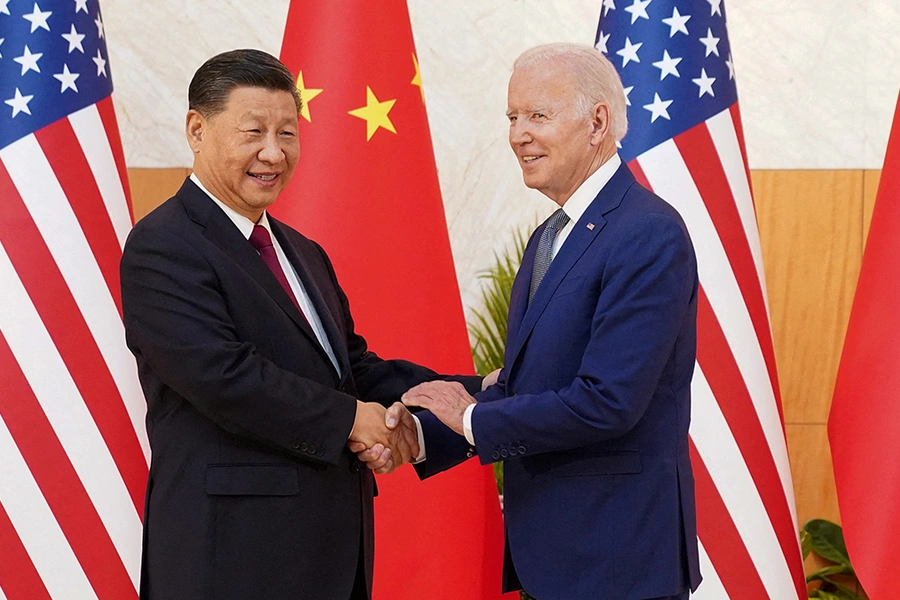U.S.-China Relations: A Breakdown Leading To A Potential New Cold War Scenario

Table of Contents
Economic Competition and Trade Wars
The economic relationship between the U.S. and China is a major source of friction, characterized by a persistent trade deficit and escalating trade wars. This section examines the key aspects of this economic rivalry.
The Trade Deficit and Tariffs
For decades, the U.S. has run a significant trade deficit with China. This imbalance, fueled by cheaper Chinese manufacturing and exports, has been a source of contention. In response, both countries have imposed tariffs on each other's goods, leading to a trade war that has impacted global markets.
- Impact on American businesses: Many American businesses, particularly those reliant on imports from China, have faced increased costs and reduced competitiveness due to tariffs. Smaller businesses have been disproportionately affected.
- Chinese retaliatory measures: China has retaliated with tariffs on American goods, impacting various sectors including agriculture and manufacturing. This has led to job losses and economic uncertainty in the U.S.
- Effects on consumer prices: Tariffs have contributed to increased consumer prices in both countries, reducing purchasing power and impacting overall economic growth. This has a significant knock-on effect on global inflation. The US-China trade war continues to be a major factor in global economic instability.
Technological Rivalry and Intellectual Property
The competition between the U.S. and China extends beyond trade to encompass a fierce battle for technological dominance. This rivalry is particularly acute in high-tech sectors such as 5G, artificial intelligence (AI), and semiconductors. Concerns regarding intellectual property theft further exacerbate these tensions.
- Examples of specific technological disputes: Disputes over 5G technology, Huawei's access to global markets, and allegations of Chinese theft of American trade secrets in various technological fields are just a few examples.
- The role of patents and trade secrets: Protecting intellectual property rights is critical for innovation and economic growth. The lack of robust protection in China, combined with allegations of intellectual property theft, has created a significant point of contention.
- Implications for national security: Technological superiority is increasingly viewed as vital for national security, as seen in the competition for dominance in AI and advanced weaponry. This technological arms race adds another layer of complexity to the existing tensions. The US-China technological rivalry is seen by many analysts as a key defining factor of the 21st century.
Geopolitical Rivalry and Regional Conflicts
Beyond economic competition, geopolitical rivalry plays a significant role in escalating U.S.-China tensions. Several regional conflicts serve as flashpoints for this rivalry.
South China Sea Disputes
China's increasingly assertive actions in the South China Sea, including its island-building activities and claims over vast swathes of maritime territory, have raised concerns about regional stability and freedom of navigation.
- China's island building: China's construction of artificial islands in the South China Sea, complete with military installations, has been met with strong criticism from neighboring countries and the U.S.
- Freedom of navigation concerns: The U.S. Navy regularly conducts freedom of navigation operations in the South China Sea to challenge China's claims and uphold international law. These actions, however, often increase tensions between the two nations.
- U.S. naval deployments: The increased presence of U.S. naval assets in the region is seen by some as a necessary deterrent to China's aggression, while others view it as a provocative escalation of the situation. The South China Sea is a major geopolitical flashpoint and a key area of concern in U.S.-China relations.
Taiwan and the Question of Independence
The status of Taiwan is one of the most sensitive issues in U.S.-China relations, with the potential for military conflict. China views Taiwan as a breakaway province and has vowed to reunify it with the mainland, by force if necessary.
- China's "One China" policy: China's unwavering adherence to the "One China" policy, which rejects Taiwanese independence, is a core principle underpinning its foreign policy toward Taiwan.
- Taiwan's democratic government: Taiwan enjoys a vibrant democracy and maintains its own distinct identity, separate from mainland China. This fundamental difference in political systems is a major point of contention.
- U.S. arms sales to Taiwan: The U.S. provides Taiwan with defensive weaponry, a policy intended to deter any potential Chinese invasion. However, these arms sales often exacerbate tensions with China. The issue of Taiwan independence remains a significant trigger point for potential military escalation between the U.S. and China.
Ideological Differences and Human Rights
Fundamental differences in political systems and ideologies further contribute to the strained relationship between the U.S. and China.
Democracy vs. Authoritarianism
The contrast between the U.S.'s democratic system and China's authoritarian regime is a source of ongoing tension. Human rights concerns in China, particularly regarding issues such as freedom of speech, religious freedom, and treatment of ethnic minorities, are frequently raised by the U.S. and its allies.
- Human rights concerns in China: The human rights situation in China, including the treatment of Uyghurs in Xinjiang and the suppression of dissent, is a significant point of disagreement between the two nations.
- Censorship and freedom of speech: China's strict censorship and limitations on freedom of speech contrast sharply with the U.S.'s emphasis on these freedoms. This fundamental ideological difference fuels mistrust and antagonism.
- Differing views on international norms: The U.S. and China often hold opposing views on international norms and institutions, leading to disagreements on issues ranging from climate change to international law. The divergent values and political systems are key factors in the overall U.S.-China relationship.
Influence and Propaganda
Both the U.S. and China engage in propaganda and disinformation campaigns to shape international perceptions and advance their national interests.
- Examples of Chinese and U.S. propaganda strategies: Both countries utilize various strategies, including state-controlled media, social media campaigns, and diplomatic initiatives, to project their narratives and influence global opinion.
- The use of social media: Social media platforms have become battlegrounds for propaganda and disinformation, with both countries vying to control the narrative and shape public perception.
- Impact on global perceptions: These propaganda efforts have a significant impact on how the U.S. and China are perceived globally, often exacerbating existing tensions and mistrust. The information war between the U.S. and China represents a significant challenge in understanding their relationship.
Conclusion
The complex and multifaceted relationship between the U.S. and China is at a critical juncture. Economic competition, geopolitical tensions, and ideological differences contribute to a scenario that bears a striking resemblance to a new Cold War. Understanding the dynamics of U.S.-China relations, from trade wars to regional conflicts and ideological clashes, is crucial for navigating this precarious situation. Failure to address these issues effectively could lead to further escalation and potentially catastrophic consequences. We must actively engage in diplomatic efforts to de-escalate tensions and find common ground to avoid a full-blown U.S.-China Cold War. Further research into the various facets of U.S.-China relations is encouraged to foster a more informed and nuanced understanding of this critical geopolitical relationship. Continued monitoring of U.S.-China relations is vital to mitigate potential future conflicts.

Featured Posts
-
 Covid 19 Pandemic Lab Owners Guilty Plea For Fake Test Results
Apr 22, 2025
Covid 19 Pandemic Lab Owners Guilty Plea For Fake Test Results
Apr 22, 2025 -
 The Case For Breaking Up Google Examining The Risks And Rewards
Apr 22, 2025
The Case For Breaking Up Google Examining The Risks And Rewards
Apr 22, 2025 -
 Death Of Pope Francis The End Of An Era
Apr 22, 2025
Death Of Pope Francis The End Of An Era
Apr 22, 2025 -
 Ai Digest Transforming Repetitive Documents Into Engaging Poop Podcasts
Apr 22, 2025
Ai Digest Transforming Repetitive Documents Into Engaging Poop Podcasts
Apr 22, 2025 -
 Understanding Stock Market Valuations Bof As Advice For Investors
Apr 22, 2025
Understanding Stock Market Valuations Bof As Advice For Investors
Apr 22, 2025
